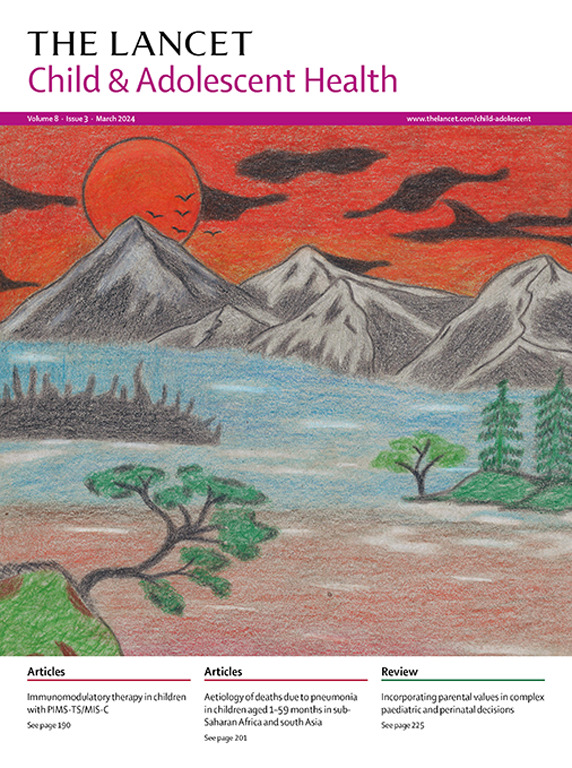亚洲儿童感染的风险分层使用宿主免疫和内皮活化标记(斑点败血症):一项多国、前瞻性、队列研究
IF 15.5
1区 医学
Q1 PEDIATRICS
引用次数: 0
摘要
在资源有限的社区环境中,迫切需要发热性疾病的预后工具。循环免疫和内皮细胞激活标志物对常见儿童感染的风险进行分层。我们的目的是评估它们在亚洲农村地区患有发热性疾病的儿童中的应用。方法spot败血症是一项前瞻性队列研究,涉及孟加拉国、柬埔寨、印度尼西亚、老挝和越南的七家医院,这些医院是农村人口与正规卫生保健系统的第一接触点。如果儿童年龄在1-59个月,并且出现持续不超过14天的社区获得性急性发热性疾病,则符合条件。记录临床参数,并在发病时测量生物标志物浓度。主要结局指标为入组后2天内出现严重发热性疾病(死亡或接受器官支持)。采用受者工作特征曲线下加权面积(AUC)比较内皮活化标志物(ANG-1、ANG-2和可溶性FLT-1)、免疫活化标志物(CHI3L1、CRP、IP-10、IL-1ra、IL-6、IL-8、IL-10、PCT、可溶性TNF-R1、可溶性TREM1 [sTREM1]和可溶性uPAR)、WHO危险体征、利物浦快速顺序性器官衰竭评估(LqSOFA)评分和全身炎症反应综合征(SIRS)评分的预后准确性。在加权逻辑回归模型中分析结合世卫组织危险信号和最佳表现生物标志物的预后准确性。使用加权分类方法比较世卫组织危险体征和表现最佳的生物标志物的预后准确性,并确定需要检测的儿童数量(NNT),以确定另一名可能发展为严重发热性疾病的儿童。该研究已在ClinicalTrials.gov注册,编号NCT04285021。在2020年3月5日至2022年11月4日期间招募了3423名参与者,其中18人(0.5%)失去了随访。3405名参与者中133人(3.9%)出现严重发热性疾病(22人死亡,111人接受器官支持;加权患病率0.34% [95% CI 0.28 - 0.41])。strem - 1在识别将发展为严重发热性疾病的患者方面表现出最高的预后准确性(AUC 0.86 [95% CI 0.82 - 0.90]),优于who危险信号(0.75 [0.71 - 0.80]);p< 0.0001), LqSOFA (0.74 [0.69 - 0.78];p< 0.0001), SIRS (0.63 [0.58 - 0.68];术;0·0001)。将世卫组织危险信号与sTREM1联合使用(0.88 [95% CI 0.85 - 0.91])与单独使用sTREM1相比,并没有提高识别重症发热性疾病进展的准确性(p= 0.24)。sTREM1鉴别重症发热性疾病进展的敏感性(0.80 [95% CI 0.73 - 0.85])高于WHO危险体征(0.72 [0.66 - 0.79]);NNT=3000),而特异性具有可比性(sTREM1的0.81[0.78 - 0.83]与WHO危险信号的0.79[0.76 - 0.82])。在入组后超过48小时进展达到结局的儿童中,免疫和内皮活化标志物的鉴别效果最好(strem: AUC 0.94 [95% CI 0.89 - 0.98])。解释strem 1在鉴别儿童是否会发展为严重发热性疾病方面表现出最好的预测准确性。在资源受限的社区环境中,基于strem1的分诊策略可能会提高对出现发热性疾病的儿童预后不良风险的早期认识。为西班牙无国界组织和惠康基金会提供资金。摘要的阿拉伯文和法文译本见补充资料部分。本文章由计算机程序翻译,如有差异,请以英文原文为准。
Risk stratification of childhood infection using host markers of immune and endothelial activation in Asia (Spot Sepsis): a multi-country, prospective, cohort study
Background
Prognostic tools for febrile illnesses are urgently required in resource-constrained community contexts. Circulating immune and endothelial activation markers stratify risk in common childhood infections. We aimed to assess their use in children with febrile illness presenting from rural communities across Asia.
Methods
Spot Sepsis was a prospective cohort study across seven hospitals in Bangladesh, Cambodia, Indonesia, Laos, and Viet Nam that serve as a first point of contact with the formal health-care system for rural populations. Children were eligible if aged 1–59 months and presenting with a community-acquired acute febrile illness that had lasted no more than 14 days. Clinical parameters were recorded and biomarker concentrations measured at presentation. The primary outcome measure was severe febrile illness (death or receipt of organ support) within 2 days of enrolment. Weighted area under the receiver operating characteristic curves (AUC) were used to compare prognostic accuracy of endothelial activation markers (ANG-1, ANG-2, and soluble FLT-1), immune activation markers (CHI3L1, CRP, IP-10, IL-1ra, IL-6, IL-8, IL-10, PCT, soluble TNF-R1, soluble TREM1 [sTREM1], and soluble uPAR), WHO danger signs, the Liverpool quick Sequential Organ Failure Assessment (LqSOFA) score, and the systemic inflammatory response syndrome (SIRS) score. Prognostic accuracy of combining WHO danger signs and the best performing biomarker was analysed in a weighted logistic regression model. Weighted measures of classification were used to compare prognostic accuracies of WHO danger signs and the best performing biomarker and to determine the number of children needed to test (NNT) to identify one additional child who would progress to severe febrile illness. The study was prospectively registered on ClinicalTrials.gov, NCT04285021.
Findings
3423 participants were recruited between March 5, 2020, and Nov 4, 2022, 18 (0·5%) of whom were lost to follow-up. 133 (3·9%) of 3405 participants developed severe febrile illness (22 deaths, 111 received organ support; weighted prevalence 0·34% [95% CI 0·28–0·41]). sTREM1 showed the highest prognostic accuracy to identify patients who would progress to severe febrile illness (AUC 0·86 [95% CI 0·82–0·90]), outperforming WHO danger signs (0·75 [0·71–0·80]; p<0·0001), LqSOFA (0·74 [0·69–0·78]; p<0·0001), and SIRS (0·63 [0·58–0·68]; p<0·0001). Combining WHO danger signs with sTREM1 (0·88 [95% CI 0·85–0·91]) did not improve accuracy in identifying progression to severe febrile illness over sTREM1 alone (p=0·24). Sensitivity for identifying progression to severe febrile illness was greater for sTREM1 (0·80 [95% CI 0·73–0·85]) than for WHO danger signs (0·72 [0·66–0·79]; NNT=3000), whereas specificities were comparable (0·81 [0·78–0·83] for sTREM1 vs 0·79 [0·76–0·82] for WHO danger signs). Discrimination of immune and endothelial activation markers was best for children who progressed to meet the outcome more than 48 h after enrolment (sTREM1: AUC 0·94 [95% CI 0·89–0·98]).
Interpretation
sTREM1 showed the best prognostic accuracy to discriminate children who would progress to severe febrile illness. In resource-constrained community settings, an sTREM1-based triage strategy might enhance early recognition of risk of poor outcomes in children presenting with febrile illness.
Funding
Médecins Sans Frontières, Spain, and Wellcome.
Translations
For the Arabic and French translations of the abstract see Supplementary Materials section.
求助全文
通过发布文献求助,成功后即可免费获取论文全文。
去求助
来源期刊

Lancet Child & Adolescent Health
Psychology-Developmental and Educational Psychology
CiteScore
40.90
自引率
0.80%
发文量
381
期刊介绍:
The Lancet Child & Adolescent Health, an independent journal with a global perspective and strong clinical focus, presents influential original research, authoritative reviews, and insightful opinion pieces to promote the health of children from fetal development through young adulthood.
This journal invite submissions that will directly impact clinical practice or child health across the disciplines of general paediatrics, adolescent medicine, or child development, and across all paediatric subspecialties including (but not limited to) allergy and immunology, cardiology, critical care, endocrinology, fetal and neonatal medicine, gastroenterology, haematology, hepatology and nutrition, infectious diseases, neurology, oncology, psychiatry, respiratory medicine, and surgery.
Content includes articles, reviews, viewpoints, clinical pictures, comments, and correspondence, along with series and commissions aimed at driving positive change in clinical practice and health policy in child and adolescent health.
 求助内容:
求助内容: 应助结果提醒方式:
应助结果提醒方式:


